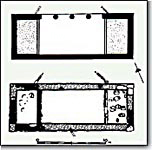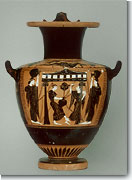

The transformation of large Greek communities from the loose structure of the ethnos to the more organized form of the polis occured before
It should be noted that at that time the ethnos coexists with the city as a political system and it is possible to define it more easily through a comparison between the two. While cities were organized around an urban centre, that was not the case of the ethne. In an ethnos, people lived dispersed in villages covering more or less a wide area. This geographical expansion, sometimes was a determining factor for the non-existence of centralization in the ethne. Moreover, with the only exception of the Locrians and the Achaeans, ethne did not participate in colonization during the Archaic period. However, they were in a position to raise an army, declare war, impose taxes, mint coinage and make laws, thus acting like cities. Their main difference was that the ethnos was not based on the body of citizens.
The institution of slavery of the citizens themselves continued to exist in the ethnos, while, in the case of the city it was abolished, since it conflicted with its ideology. It is maintained that for the first time at that period, the polis founded its development on the use of owned slaves, as workforce coming from regions outside the Greek mainland.
|
The economy of the Archaic city was primarily characterized as rural and agriculture constituted the main source both for the survival of the masses and the enrichment of the majority of wealthy people. Another factor which contributed to the development of the city's economy was the keen activity in the field of public building constructions in the city, as well as in the organization of religious celebrations, especially during the time of tyrannies. |
 |
 |
Constructions of aqueducts and fountains in urban centres date from the end of the 7th-beginning of the |
Because in most cases the Greek polis was released of the responsibility to supply for the hoplite equipment, a strong economic foundation was needed mostly in order to build and organize the fleet -since the period of the tyranny- but also in order to offer public meals and presents to the winners of games.
The income came from port dues, from Agora fees, from hiring public land and from indirect -and later direct- taxes relating to land owning.
Most profitable among the above sources of income was the taxation of the agora and the ports. The city as an offset to this exploitation stabilized its weights and measures, minted coinage and improved its water supply and its ports by constructing works of public benefit. Such examples are the diolkos of Corinth, the famous tunnel of Samos, a work by Eupalinus, and the mole of Delos.
|
| |
|
Note: Click on a picture for a brief description. | |